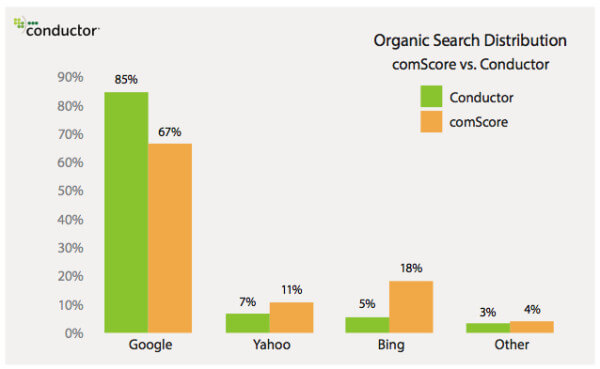The Recirculation Gap: Why Google Sends More Traffic Than Its Search Market Share Suggests
How can publishers receive a greater percentage of search traffic from Google than the market share Google has in the U.S.? It’s likely due to what I call “The Recirculation Gap” and how Google probably “recirculates” searches back into itself less than Yahoo and Bing. Every month for ages, it seems the same. comScore releases a “U.S. […]
How can publishers receive a greater percentage of search traffic from Google than the market share Google has in the U.S.? It’s likely due to what I call “The Recirculation Gap” and how Google probably “recirculates” searches back into itself less than Yahoo and Bing.
Every month for ages, it seems the same. comScore releases a “U.S. Search Engine Rankings” report that shows Google with around two-thirds of the market. That suggests to some that publishers should get two-thirds of their search traffic from Google. But they don’t. Publishers commonly report getting more than this, sometimes much more.
This oddity is in the news again after being largely forgotten for years, because the folks at Conductor are out with a “Why You Shouldn’t Trust comScore’s Numbers for Search Engine Market Share” white paper.
The paper notes that based on Conductor’s analysis of 100 million search engine-related visits to its clients’ web sites, Google sends 85% of search traffic, not 68% as you might think based on comScore’s most recent figures. Both Yahoo and Bing send less traffic than some might expect:
The issue is that Conductor is doing an apples-to-oranges comparison. Or maybe tangerine-to-oranges. comScore’s figures might seem to be measuring the same thing as Conductor’s, but they’re not.
comScore: Measuring Searches “Pre-click” Or “Before-The-Click”
The figures from comScore look at the actual number of searches happening at each of the major search engines.
It doesn’t matter where someone goes after clicking on a search listing. comScore is rooted in the “before-the-click” behavior. Any search gets counted; destination doesn’t matter.
Conductor: Measuring Traffic “Post-Click” or “After-The-Click”
The figures from Conductor look at the traffic publishers receive from search engines.
Here, the post-click activity is crucial. If someone does a search on a search engine and clicks on a link that leads them back into that search engine, Conductor can’t measure that.
The Recirculation Gap
As a result, Conductor is not getting the full picture of what’s happening with all those searches that comScore is seeing. To me, that’s the primary reason why a “gap” seems to appear.
As I said earlier, this issue is ages old. That last time it got serious attention was in 2006, when Rich Skrenta wrote about Google’s “true market” share being 70%, when measurement service Hitwise was reporting it as 40%. And as I wrote about it at the time:
But a search for something on Yahoo Sports? That might be counted as a “search,” and it is — but it’s not the type of search that would register with site-based metrics. The searcher might stay entirely inside Yahoo.
I’d written and spoken about the gap even before then and talked about how some of it is probably due to recirculation back into a search engine. So let me finally put a name on it: “The Recirculation Gap” along with a definition:
The Recirculation Gap: The difference between the share of searches a search engine handles and traffic it sends to third parties.
Search engines with the biggest position gap likely favor themselves more. That makes Bing the leader among the major U.S. search engines, with a 13% gap. Google, as has been the case for years whenever I’ve looked at such gaps, favors itself the least. It has a -18% gap.
Is There Another Reason?
Of course, there could be other reasons for the gap beyond recirculation, though what those are, no one has seriously explored over the years.
I did ask comScore freshly about this. One thing it suggested was that mobile might be a factor, since it says Google has a higher share of mobile search than compared to desktop figures. And those comScore figures above are desktop-only.
So when will comScore add mobile figures to its regular reporting? It’s something in development, I was told, but there’s no set date.
In the end, both comScore’s and Conductor’s figures tell you the same thing: Google is important. If you’re after search traffic, you can’t ignore Google. It’s a huge slice of the search pie.
Contributing authors are invited to create content for Search Engine Land and are chosen for their expertise and contribution to the search community. Our contributors work under the oversight of the editorial staff and contributions are checked for quality and relevance to our readers. The opinions they express are their own.
Related stories
New on Search Engine Land
